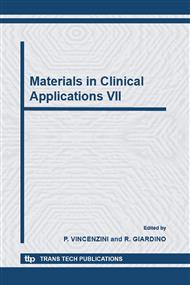p.222
p.227
p.235
p.240
p.246
p.252
p.258
p.263
p.269
In Vitro Reactivity of Bioactive Glass Fibers
Abstract:
Implants with long lasting bioactivity and mechanical sustainability would be of interest in several novel clinical applications. By processing bioactive glass fibers and biodegradable polymers into 3D structures, bone formation ability of glasses and flexibility of polymers can be combined. In order to achieve desired physiological response, reactivity of bioactive glass fibers must be specified. Bundles of fibers within the range of bioactivity were soaked in the simulated body fluid at stationary conditions for several time intervals after which the cross-sectional surfaces of the fibers were studied with SEM-EDXA. The reaction layers and precipitations formed on the fiber surfaces suggest that the fibers react according to three mechanisms depending on the glass composition. Fibers with a high in vitro bioactivity showed the formation of distinct and thick silica –rich and calcium phosphate –rich layers already at one day’s immersion. Fibers of medium bioactivity did not show any clear silica –rich layer but a formation of calcium phosphate precipitations or layers at one day’s immersion. Slow glasses showed sporadic calcium phosphate precipitation only after the longest immersion times. The results indicate that the medium and slow glasses are interesting alternatives for applications where a long term mechanical durability suggested by their slow reactivity in combination with their osteoconductive tendency is desired.
Info:
Periodical:
Pages:
246-251
Citation:
Online since:
October 2006
Keywords:
Price:
Сopyright:
© 2006 Trans Tech Publications Ltd. All Rights Reserved
Share:
Citation:


